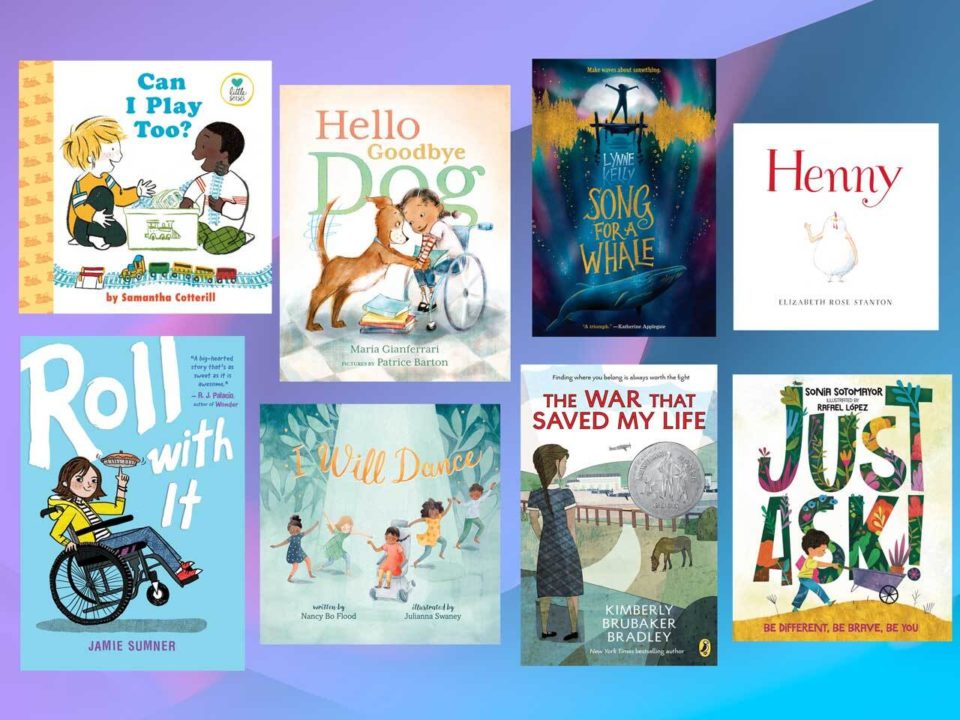With a child psychology background, Nancy Bo Flood has always been interested in finding ways that children with disabilities can become part of every community. That’s why she was intrigued when she learned about Young Dance, a Minnesota-based youth dance company that serves students of all abilities. In 2012, she started going to Young Dance’s performances, then asked to go to rehearsals and observe classes.
“[Students with disabilities] participated fully in movement and in creating the performance,” Flood, an author based in Colorado, explains. “There wasn’t the feeling of ‘Oh here, let us help you.’”
One student in particular captured her attention: A young girl named Eva. Eva used a power wheelchair, and could only move her head, arms, and fingers. “I noticed the way her face glowed with joy,” Flood remembers. “I was amazed by her. No one took pity on her or felt sadness for her and that was such a beautiful part of it.”
Flood was inspired to write a children’s book based on Eva and her experiences with Young Dance. As she researched the book, Flood learned that Eva’s parents had offered to find her private dance lessons because of her disability, but Eva didn’t want to dance alone. “She wanted to be part of a community,” Flood explains. “Children with disabilities are sometimes shut out or put on the sideline, but here they are equal participating members.”
Flood’s finished book, I Will Dance, shows a child’s common dream of wanting to be a dancer, with the added barrier of learning to do so from a wheelchair. Likewise, the other books shown here feature differently-abled characters through a variety of situations that every child experiences, such as moving to a new town, learning to make a friend, or loving a favorite pet.
“All children need to see themselves in books,” says Flood. “All children have things they really want to become, and children with disabilities are just the same—we all feel these things.”
I Will Dance
by Nancy Bo Flood; illustrated by Julianna Swaney (Atheneum, 2020)
Eva wants to learn to dance even though she has cerebral palsy. She discovers a dance company that will include her, and goes through a range of emotions in learning to dance and reacting to the movements of others. Age four and up.
The War that Saved My Life
by Kimberly Brubaker Bradley (Puffin Books, 2016)
Ada has never left her one-bedroom apartment because her mother is too embarrassed of her twisted foot. When her brother is shipped out of London to escape World War II, Ada sneaks away with him, and teaches herself to ride a pony, read, and watch for German spies. Grades eighth to 12th.
Henny
by Elizabeth Rose Stanton (Paula Wiseman Books, 2014)
Henny is different from the other chickens in the barn. Instead of wings, she has arms! Sometimes she likes being different, but sometimes she wishes she could do things the way the other chickens do. Ages four to eight.
Song for a Whale
by Lynne Kelly (Yearling, 2019)
A deaf girl named Iris learns about a real whale who is unable to speak to other whales. She becomes determined to write a song for him, even though he is 3,000 miles away. Grades eighth to 12th.
Can I Play Too?
by Samantha Cotterill (Dial Books, 2020)
Part of the Little Senses series, this story helps kids on the autism spectrum learn to understand social cues. A teacher guides two boys playing with trains, explaining how to tell when a friend is feeling frustrated or angry, and how to ask for a do-over. Ages three to seven.
Hello Goodbye Dog
by Maria Gianferrari; illustrated by Patrice Barton (Roaring Brook Press, 2017)
Moose the dog loves being with his favorite girl, Zara, who uses a wheelchair, even when she is at school where dogs aren’t allowed. Moose keeps trying to find his way back to Zara, with disastrous results. But with training and a good idea, Moose and Zara figure out how they can be together. Ages four to eight.
Roll With It
by Jamie Sumner (Atheneum, September 1, 2020)
Ellie, who has cerebral palsy, has big dreams of becoming a professional baker. But when her family has to move, she becomes the new kid in a wheelchair who lives on the wrong side of town. It feels like too many challenges to overcome until Ellie makes her first friends. Age 10 and up.
Just Ask!
by Sonia Sotomayor; illustrated by Rafael López (Philomel Books, 2019)
Diagnosed with diabetes as a young girl, Supreme Court Justice Sonia Sotomayor uses her own experiences to teach children about all sorts of physical challenges and mental conditions—a different one on every page. Ages four to eight.
Other stories featuring differently-abled characters include:
- Gary’s Gigantic Dream by Dr. Nicole Julia; illustrated by Jeff Crowther
- Too Sticky! by Jen Malia; illustrated by Joanne Lew-Vriethoff
- Superheroes Club by Madeleine Sherak, Ph.D; illustrated by Esther Yee Sol Choi
- Ben’s Adventures by Elizabeth Gerlach
- El Deafo by Cece Bell
- Out of My Mind by Sharon M. Draper
- Fish in a Tree by Lynda Mullaly Hunt
- I Funny (series) by James Patterson
- Voyagers (series) by D.J. MacHale
- Meena Meets her Match by Karla Manternach; illustrated by Rayner Alencar
- Let’s Dance by Valerie Bolling; illustrated by Maine Diaz
- Jeremiah Justice Saves the Day by Melissa Miles; illustrated by Rashad Doucet
- Speechless by Kate Darbishire; illustrated by Peter Haillay
- Everything I’ve Never Said by Samantha Wheeler
- Gracie Fairshaw and the Mysterious Guest by Susan Brownrigg; illustrated by Jenny Czerwonka
- A Boy Named Bat by Elana K. Arnold; illustrated by Charles Santoso
- Georgia Rules by Nanci Turner Steveson
- Insignificant Events in the Life of a Cactus by Dusti Bowling





